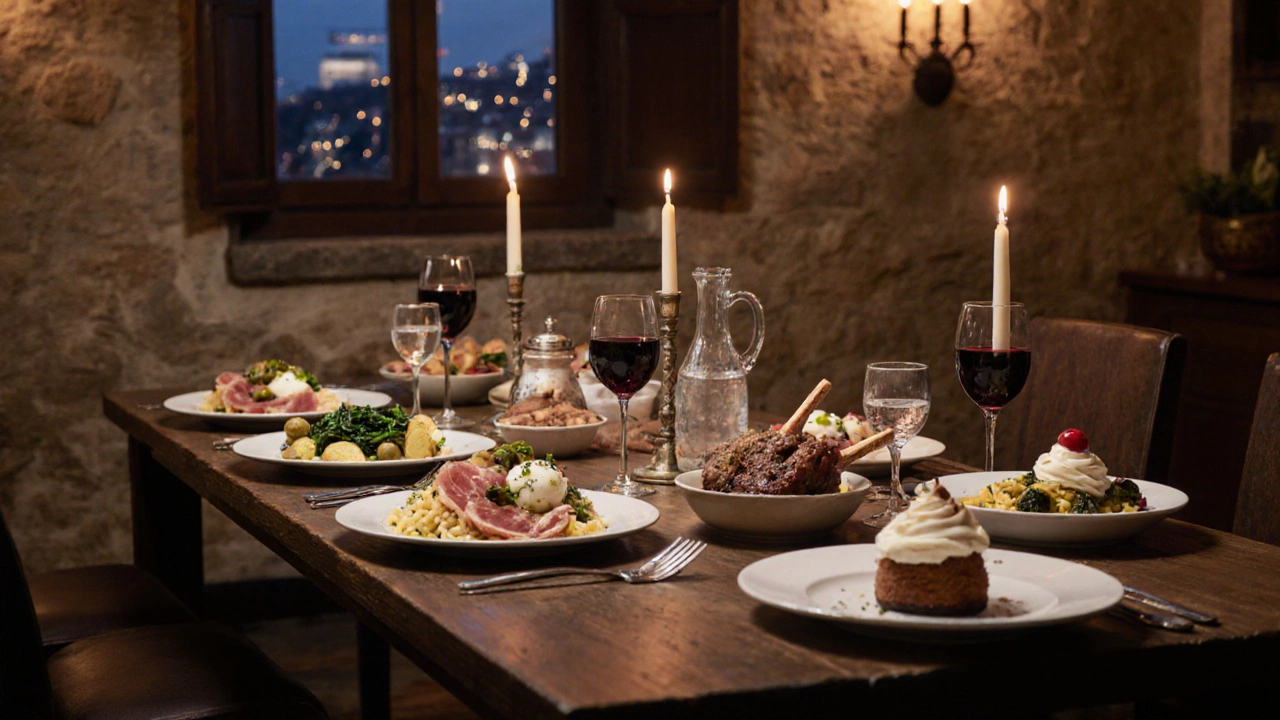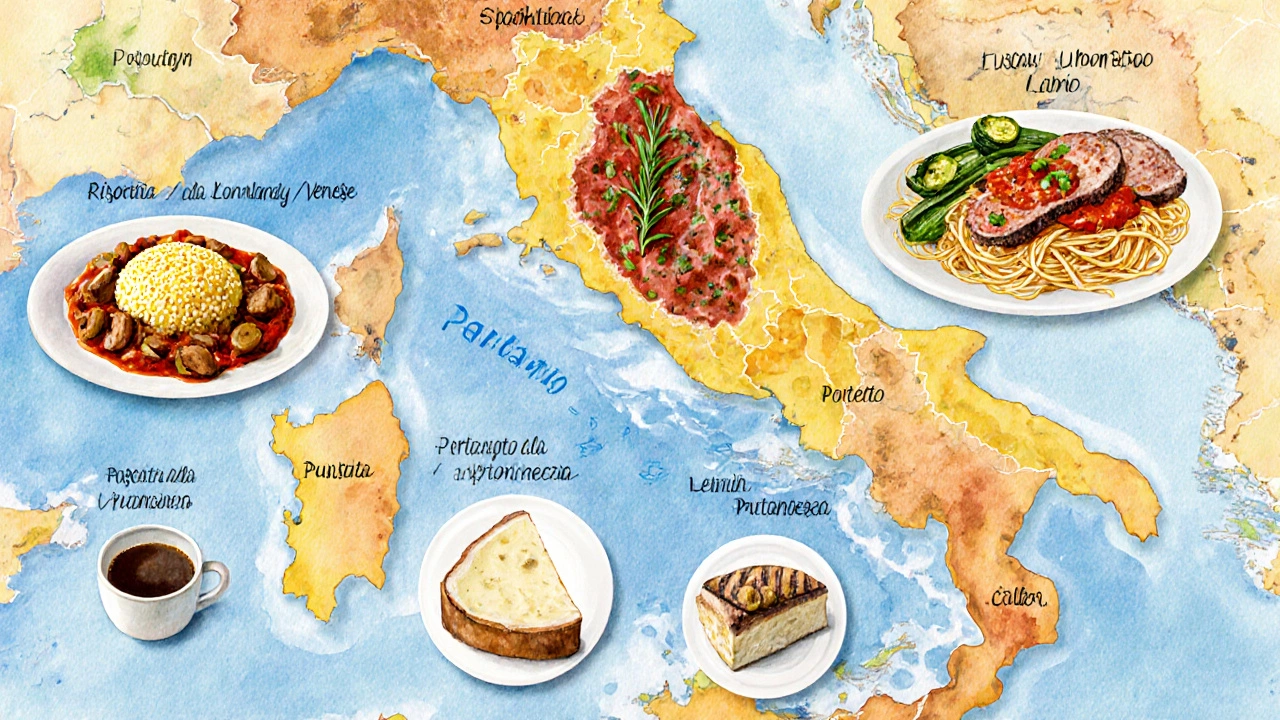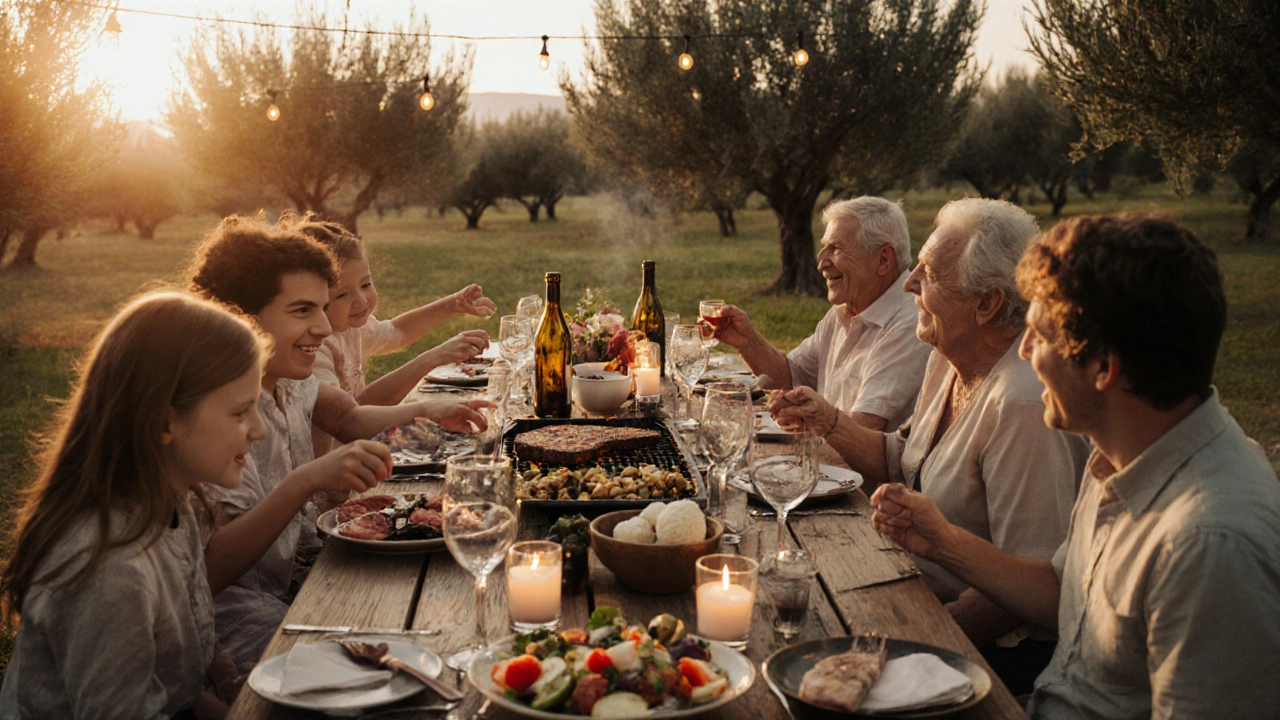
Italian Dinner Planner
Create Your Authentic Italian Dinner
Your Authentic Italian Dinner
Course-by-Course Menu
Ever wondered what an authentic Italian dinner means in everyday life across Italy looks like? Forget the stereotype of endless pasta. Italians actually follow a multi‑course rhythm that changes by region, season, and even the day of the week. This guide walks you through each course, highlights the most common dishes, and shows how you can bring a real Italian evening to your own kitchen.
Key Takeaways
- Italian dinners typically follow a 5‑course structure: antipasto, primo, secondo, contorno, and dolce.
- Regional differences shape the main dishes - think risotto in the North vs. pasta e fagioli in the South.
- Seasonal ingredients and local produce dictate what appears on the table.
- Simple drinks like wine, water, or an espresso finish the meal.
- You can recreate the experience at home with a few core ingredients and timing tricks.
How an Italian Dinner is Structured
In Italy, a dinner isn’t just a single plate; it’s a sequence of dishes that build on each other. The meals are meant to be savored, not rushed. Below is the classic order.
1. Antipasto - The Opening Bite
The Antipasto is the appetizer course that awakens the palate. Typical items include cured meats like prosciutto, olives, marinated artichokes, fresh mozzarella, and a drizzle of Olive oil extra‑virgin, often flavored with herbs. The focus is on variety and quality rather than quantity.
2. Primo - The First Main
The Primo is a carbohydrate‑rich dish, usually pasta, rice, or soup. In the North you’ll find Risotto creamy rice cooked with broth, butter, and Parmesan. Down South, the staple becomes Pasta served with sauces like arrabbiata or pesto. The serving size is modest because a second main follows.
3. Secondo - The Protein Star
The Secondo delivers the main protein, be it meat, fish, or poultry. Common choices include Osso buco braised veal shank popular in Lombardy, grilled branzino along the coast, or a simple bistecca alla Fiorentina (thick‑cut steak) in Tuscany. Accompanying sauces are light-usually a squeeze of lemon, a drizzle of olive oil, or a sprinkling of Parmigiano Reggiano aged cheese from Emilia‑Romagna.
4. Contorno - The Side Dish
Side dishes, called Contorno are vegetable or salad portions that complement the Secondo. Seasonal greens such as sautéed spinach, roasted rosemary potatoes, or a fresh caprese salad (tomato, mozzarella, basil) are typical. Italians value fresh, locally sourced produce, so the contorno changes with the market.
5. Dolce - The Sweet Finish
Even though dinner is savory, a sweet ending is customary. The Dolce can be as simple as a fruit tart or as elaborate as a layered cake. A famous example is Tiramisu a coffee‑flavored mascarpone dessert that hails from Veneto. In many households, a small serving of gelato or a piece of panettone (around holidays) finishes the meal.
Regional Flavors That Shape the Dinner Plate
Italy isn’t a culinary monolith. Geography, climate, and history create distinct dinner profiles.
North - Butter, Cream, and Polenta
In regions like Piedmont, Lombardy, and Veneto, you’ll find richer dishes. Polenta coarse cornmeal cooked to a creamy consistency, often paired with hearty stews is a staple. Butter and cream replace olive oil in sauces, giving dishes a velvety texture. Risotto, especially the saffron‑tinted Risotto alla Milanese with bone marrow and Parmigiano, shines here.
Center - Simplicity and Fresh Herbs
Tuscany, Umbria, and Lazio favor simple preparations that highlight quality ingredients. A classic dinner might start with olive‑oil‑dressed bruschetta, followed by a light Pasta al pomodoro made with San Marzano tomatoes, then grilled pork chops seasoned with rosemary, and finish with a drizzle of honey‑infused cantucci (almond cookies) beside espresso.
South - Tomato, Olive, and Bold Flavors
In Campania, Sicily, and Calabria, the sun‑kissed cuisine bursts with tomatoes, olives, and chili. Expect a dinner of Spaghetti alla puttanesca with olives, capers, and anchovies as the Primo, followed by grilled swordfish or eggplant parmigiana for the Secondo. The Contorno often includes sautéed zucchini or a fresh salad with ripe tomatoes. For Dolce, a slice of cassata (Sicilian ricotta cake) ends the night.

Seasonal and Daily Variations
Italians adapt dinner to what’s in season. In winter, soups like Minestrone filled with root vegetables and beans may replace a lighter pasta dish. Summer evenings often feature a quick grill (grigliata) with fresh veggies, letting the family eat outdoors.
Weekends are more elaborate. Families gather for multi‑course meals that can stretch for hours. On weekdays, especially in cities, the dinner may be truncated to just antipasto and a primo, or even a single pizza slice with a side salad.
Common Beverages with the Italian Dinner
- Wine - Red (Chianti, Barolo) with meat, white (Verdicchio, Pinot Grigio) with fish.
- Still or sparkling water - Served throughout the meal.
- Espresso - A small cup after dolce, never after the main courses.
- Digestivo - Amaro or Limoncello for those who want a final digestive touch.

Quick Checklist to Recreate an Authentic Italian Dinner
- Choose a regional theme (North, Center, South).
- Plan the 5‑course flow: Antipasto → Primo → Secondo → Contorno → Dolce.
- Source fresh, seasonal ingredients - local markets are gold.
- Keep portions modest; each course should leave room for the next.
- Pair wine thoughtfully - follow the classic red‑white rule.
- Finish with espresso or a small liqueur.
Frequently Asked Questions
Do Italians really eat pasta every night?
Pasta is a staple, but it’s usually reserved for the primo course. On busy weekdays, many Italians might have just a simple pasta dish with a quick sauce, skipping the later courses.
Is pizza considered a dinner or a snack?
Pizza can be a full dinner, especially in the South. It’s often served with a light salad on the side, turning it into a complete meal.
What’s the difference between "primo" and "secondo"?
Primo focuses on carbohydrates - pasta, rice, or soup - while secondo is the protein‑rich main, such as meat, fish, or legumes.
Can I substitute wine with another drink?
Yes. In families with children or non‑drinkers, sparkling water or a light fruit juice works well. The key is to keep the beverage refreshing and not overpower the food.
How long should an Italian dinner last?
A traditional multi‑course dinner can stretch to two or three hours, especially on weekends. The pace is relaxed - enjoy conversation between courses.
Conclusion - Bring Italy to Your Table Tonight
Understanding what Italians eat for dinner is more than a list of dishes; it’s about rhythm, regional pride, and respect for fresh ingredients. By following the five‑course flow, choosing season‑appropriate foods, and pairing the right wine or espresso, you can transform an ordinary evening into a genuine Italian experience. So, pick a region, gather a few key ingredients, and let the aromas guide you to a memorable dinner - just like families do across Italy.